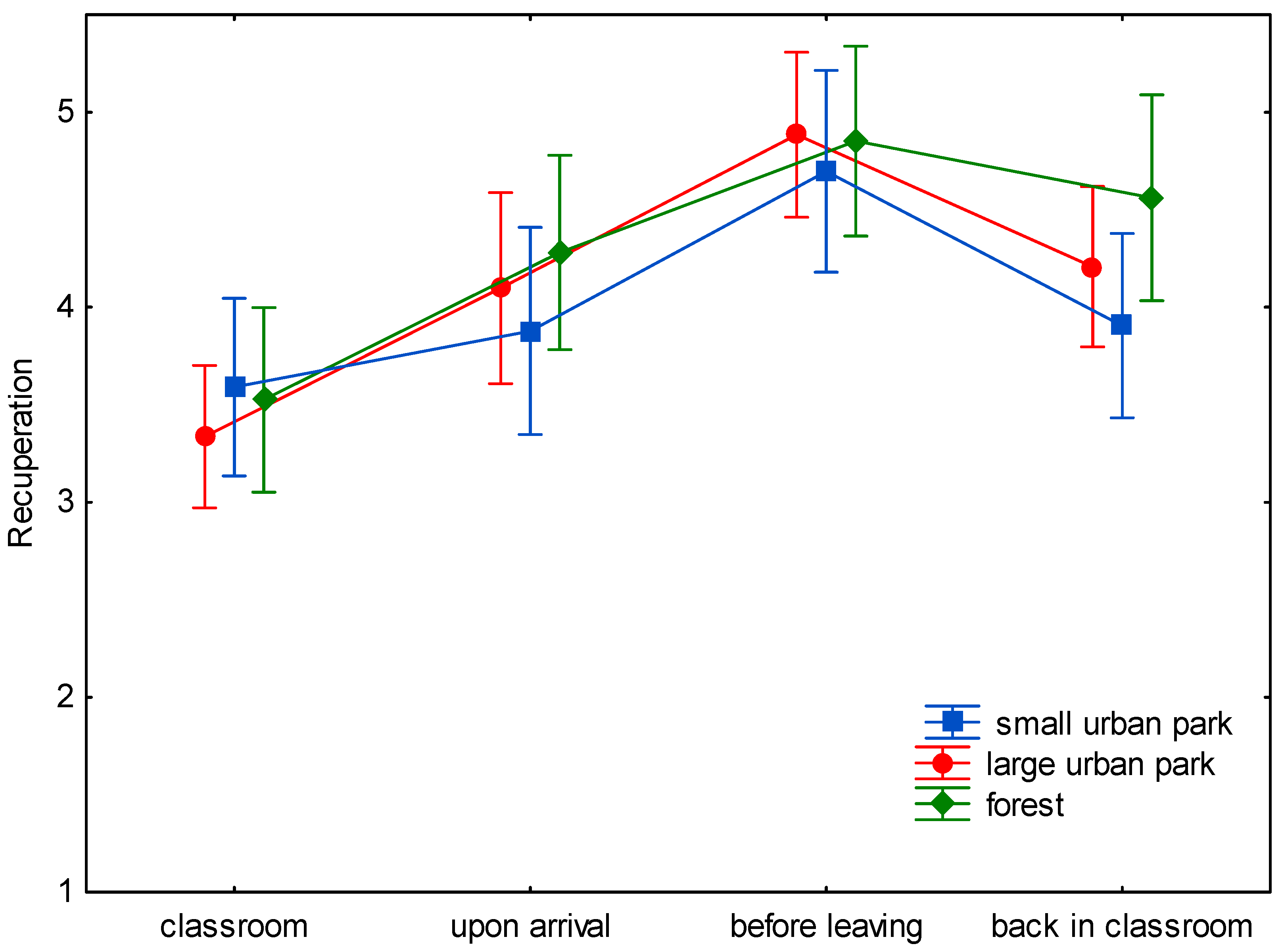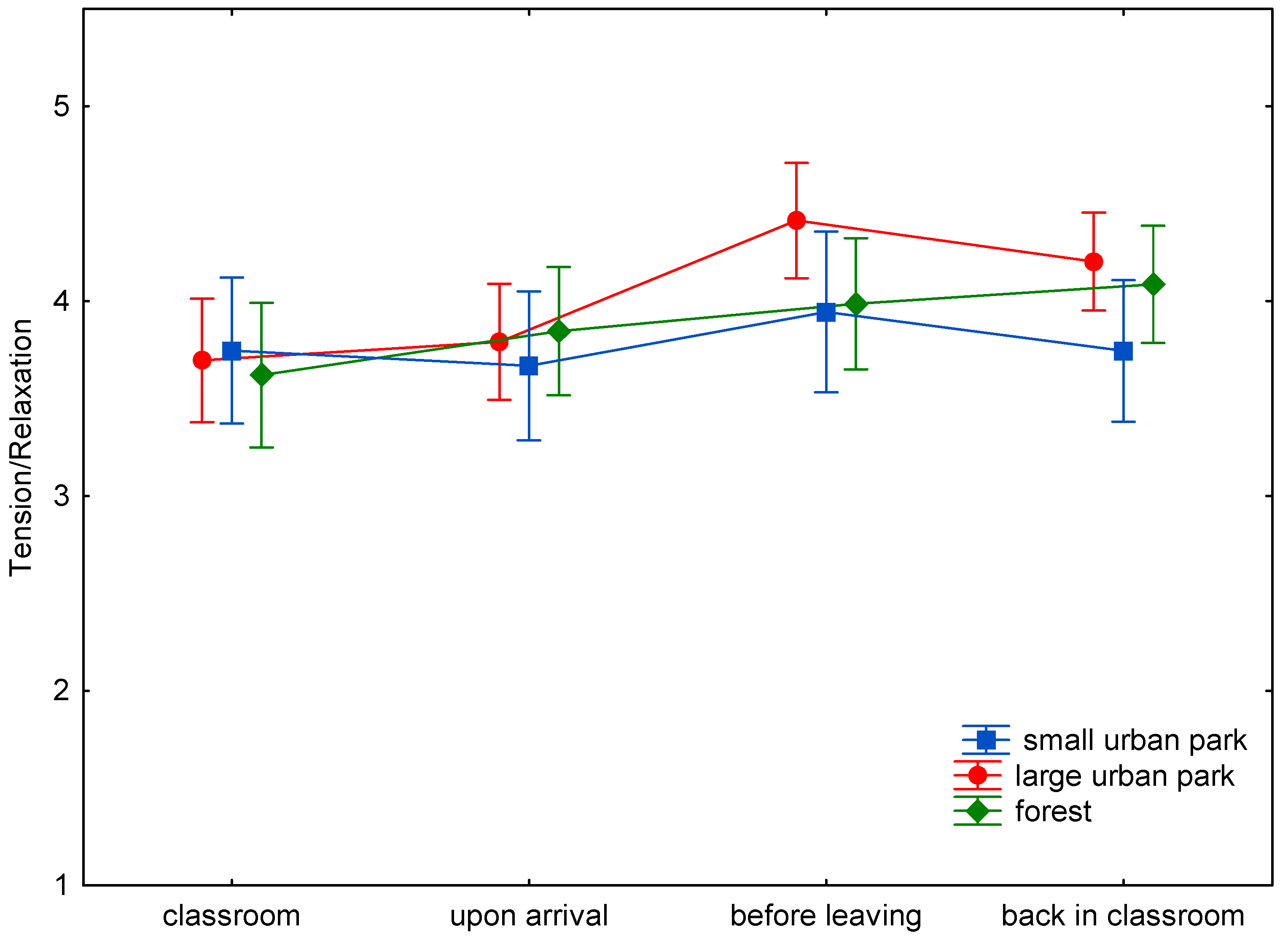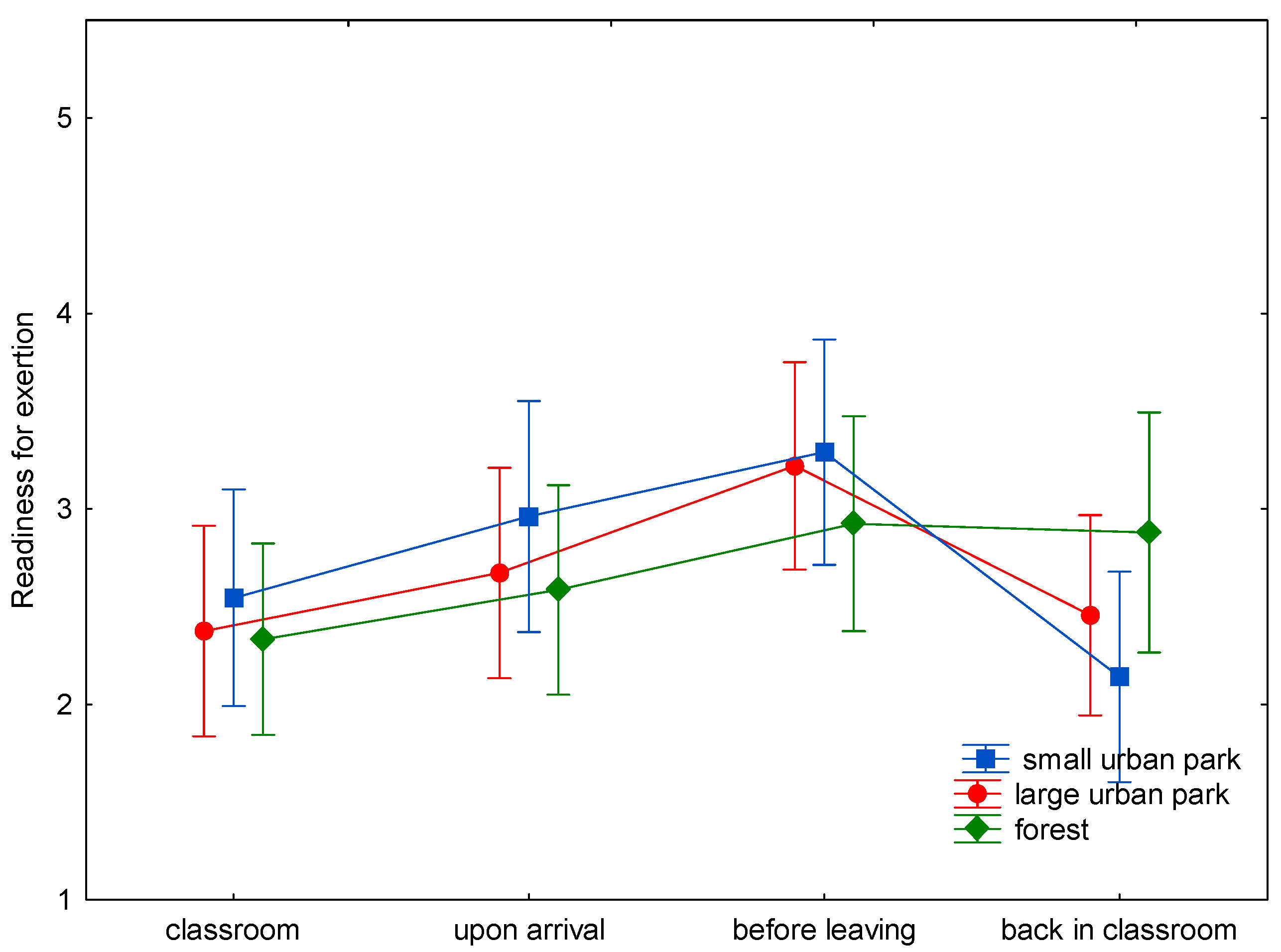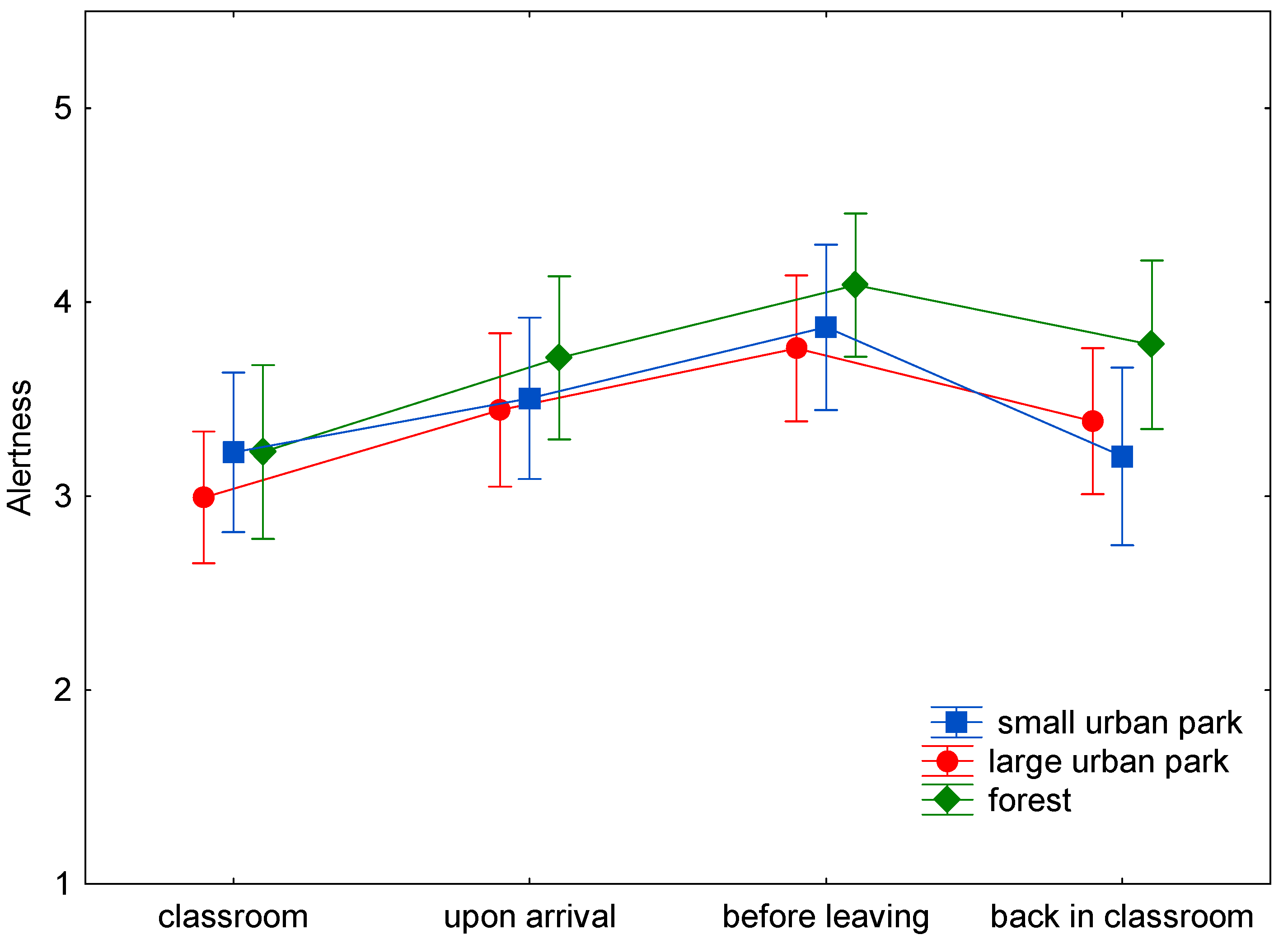Reloading Pupils’ Batteries: Impact of Green Spaces on Cognition and Wellbeing
Abstract
1. Introduction
2. Materials and Methods
Statistical Analyses
3. Results
3.1. Wellbeing
3.2. Cognitive Performance
4. Discussion
5. Conclusions
Author Contributions
Funding
Acknowledgments
Conflicts of Interest
References
- Murray, R.; Ramstetter, C.; Council on School Health; American Academy of Pediatrics. The crucial role of recess in school. Pediatrics 2013, 131, 183–188. [Google Scholar] [CrossRef] [PubMed]
- Pellegrini, A.D.; Bohn, C.M. The role of recess in children’s cognitive performance and school adjustment. Educ. Res. 2005, 34, 13–19. [Google Scholar] [CrossRef]
- Kaplan, R.; Kaplan, S. The Experience of Nature—A Psychological Perspective; Cambridge University Press: Cambridge, UK, 1989; ISBN 978-0521341394. [Google Scholar]
- Ulrich, R.S.; Simons, R.F.; Losito, B.D.; Fiorito, E.; Miles, M.A.; Zelson, M. Stress recovery during exposure to natural and urban environments. J. Environ. Psychol. 1991, 11, 201–230. [Google Scholar] [CrossRef]
- Berto, R. The Role of Nature in Coping with Psycho-Physiological Stress: A Literature Review on Restorativeness. Behav. Sci. 2014, 4, 394–409. [Google Scholar] [CrossRef] [PubMed]
- Li, D.; Sullivan, W. Impact of views to school landscapes on recovery from stress and mental fatigue. Landsc. Urban. Plan. 2016, 148, 149–158. [Google Scholar] [CrossRef]
- Kaplan, S. The restorative benefits of nature: Toward an integrated framework. J. Environ. Psychol. 1995, 15, 169–182. [Google Scholar] [CrossRef]
- Hartig, T.; Mang, M.; Evans, G.W. Restorative effects of natural environment experience. Environ. Behav. 1991, 23, 3–26. [Google Scholar] [CrossRef]
- Berto, R.; Baroni, M.R.; Zainaghi, A.; Bettella, S. An exoloratory study of the effect of high and low fascination environments on attentional fatigue. J. Environ. Psychol. 2010, 30, 494–500. [Google Scholar] [CrossRef]
- De Keijzer, C.; Gascon, M.; Nieuwenhuijsen, M.J.; Dadvand, P. Long-term green space exposure and cognition across the life course: A systematic review. Curr. Environ. Health Rep. 2016, 3, 468–477. [Google Scholar] [CrossRef] [PubMed]
- Matsuoka, R.H. Student performance and high school landscapes: Examining the links. Landsc. Urban Plan. 2010, 97, 273–282. [Google Scholar] [CrossRef]
- Tennessen, C.M.; Cimprich, B. Views to nature: Effects on attention. J. Environ. Psychol. 1995, 15, 77–85. [Google Scholar] [CrossRef]
- Berman, M.G.; Jonides, J.; Kaplan, S. The cognitive benefits of interacting with nature. Psychol. Sci. 2008, 19, 1207–1212. [Google Scholar] [CrossRef] [PubMed]
- Lee, K.E.; Williams, K.J.H.; Sargent, L.D.; Williams, N.S.G.; Johnson, K.A. 40-second green roof views sustain attention: The role of micro-breaks in attention restoration. J. Environ. Psychol. 2015, 42, 182–189. [Google Scholar] [CrossRef]
- Felsten, G. Where to take a study break on the college campus. An attention restoration theory perspective. J. Environ. Psychol. 2009, 29, 160–167. [Google Scholar] [CrossRef]
- Gilbert, N. Green space: A natural high. Nature 2016, 531, S56–S57. [Google Scholar] [CrossRef] [PubMed]
- Roe, J.J.; Thompson, C.W.; Aspinall, P.A.; Brewer, M.J.; Duff, E.I.; Miller, D.; Mitchell, R.; Clow, A. Green space and stress: Evidence from cortisol measures in deprived urban communities. Int. J. Environ. Res. Public Health 2013, 10, 4086–4103. [Google Scholar] [CrossRef] [PubMed]
- Kjellgren, A.; Buhrkall, H. A comparison of the restorative effect of a natural environment with that of a simulated natural environment. J. Environ. Psychol. 2010, 30, 464–472. [Google Scholar] [CrossRef]
- Korpela, K.M.; Ylén, M.; Tyrväinen, L.; Silvennoinen, H. Determinants of restorative experiences in everyday favorite places. Health Place 2008, 14, 636–652. [Google Scholar] [CrossRef] [PubMed]
- Hartig, T.; Evans, G.W.; Jamner, L.D.; Davis, D.S.; Gärling, T. Tracking restoration in natural and urban field settings. J. Environ. Psychol. 2003, 23, 109–123. [Google Scholar] [CrossRef]
- De Vries, S.; Verheij, R.A.; Groenewegen, P.P.; Spreeuwenberg, P. Natural environments—Healthy environments? An exploratory analysis of the relationship between greenspace and health. Environ. Plan. A 2003, 35, 1717–1731. [Google Scholar] [CrossRef]
- Van den Berg, A.E.; Koole, S.L.; van der Wulp, N.Y. Environmental preference and restoration. (How) are they related? J. Environ. Psychol. 2003, 23, 135–146. [Google Scholar] [CrossRef]
- Gascon, M.; Triguero-Mas, M.; Martinez, D.; Dadvand, P.; Forns, J.; Plasència, A.; Nieuwenhuijsen, M.J. Mental Health Benefits of Long-Term Exposure to Residential Green and Blue Spaces: A Systematic Review. Int. J. Environ. Res. Public Health 2015, 12, 4354–4379. [Google Scholar] [CrossRef] [PubMed]
- Bezold, C.P.; Banay, R.F.; Coull, B.A.; Hart, J.E.; James, P.; Kubzansky, L.D.; Missmer, S.A.; Laden, F. The Association Between Natural Environments and Depressive Symptoms in Adolescents Living in the United States. J. Adolesc. Health 2018, 62, 488–495. [Google Scholar] [CrossRef] [PubMed]
- Dzhambov, A.; Hartig, T.; Markevych, I.; Tilov, B.; Dimitrova, D. Urban residential greenspace and mental health in youth: Different approaches to testing multiple pathways yield different conclusions. Environ. Res. 2018, 160, 47–59. [Google Scholar] [CrossRef] [PubMed]
- Owens, P.E.; McKinnon, I. In pursuit of nature: The role of nature in adolescents’ lives. J. Dev. Processes 2009, 4, 43–58. [Google Scholar]
- Korpela, K.M. Children’s environment. In Handbook of Environmental Psychology; Bechtel, R.B., Churchman, A., Eds.; Wiley: New York, NY, USA, 2002; pp. 363–373. ISBN 978-0-471-40594-8. [Google Scholar]
- Kaplan, R.; Kaplan, S. Adolescents and the natural environment: A time out? In Children and Nature: Psychological, Sociocultural, and Evolutionary Investigations; Kahn, P.H., Jr., Kellert, S.R., Eds.; MIT Press: Cambridge, UK, 2002; pp. 227–257. [Google Scholar]
- White, M.P.; Pahl, S.; Ashbullby, K.; Herbert, S.; Depledge, M.H. Feelings of restoration from recent nature visits. J. Environ. Psychol. 2013, 35, 40–51. [Google Scholar] [CrossRef]
- Bixler, R.D. Nature is scary, disgusting, and uncomfortable. Environ. Behav. 1997, 29, 443–467. [Google Scholar] [CrossRef]
- Mennis, J.; Mason, M.; Ambrus, A. Urban greenspace is associated with reduced psychological stress among adolescents: A Geographic Ecological Momentary Assessment (GEMA) analysis of activity space. Landsc. Urban. Plan. 2018, 174, 1–9. [Google Scholar] [CrossRef] [PubMed]
- Chawla, L.; Keena, K.; Pevec, I.; Stanley, E. Green schoolyards as havens from stress and resources for resilience in childhood and adolescence. Health Place 2014, 28, 1–13. [Google Scholar] [CrossRef] [PubMed]
- Song, C.; Ikei, H.; Igarashi, M.; Miwa, M.; Takagaki, M.; Miyazaki, Y. Physiological and psychological responses of young males during spring-time walks in urban parks. J. Physiol. Anthropol. 2014, 33, 8. [Google Scholar] [CrossRef] [PubMed]
- Wiens, V.; Kyngäs, H.; Pölkki, T. The meaning of seasonal changes, nature, and animals for adolescent girls’ wellbeing in northern Finland. A qualitative descriptive study. Int. J Qual. Stud. Health Well-Being 2016, 11, 30160. [Google Scholar] [CrossRef] [PubMed]
- Arnberger, A.; Eder, R.; Allex, B.; Hutter, H.-P.; Wallner, P.; Bauer, N.; Zaller, J.G.; Frank, T. Perceived health benefits of managed and unmanaged meadows in a mountain biosphere reserve—An experimental study in the Austrian Alps. J. Prot. Mt. Areas Res. 2018, 10, 5–14. [Google Scholar] [CrossRef]
- Carrus, G.; Lafortezza, R.; Colangelo, G.; Dentamaro, I.; Scopelliti, M.; Sanesi, G. Relations between naturalness and perceived restorativeness of different urban green spaces. Psyecology 2013, 4, 227–244. [Google Scholar] [CrossRef]
- Marselle, M.R.; Irvine, K.N.; Lorenzo-Arribas, A.; Warber, S.L. Moving beyond green: Exploring the relationship of environment type and indicators of perceived environmental quality on emotional well-being following group walks. Int. J. Environ. Res. Public Health 2015, 12, 106–130. [Google Scholar] [CrossRef] [PubMed]
- Velarde, M.D.; Fry, G.; Tveit, M. Health effects of viewing landscapes—landscape types in environmental psychology. Urban For. Urban Green. 2007, 6, 199–212. [Google Scholar] [CrossRef]
- Van den Berg, A.; Jorgensen, A.; Wilson, E.R. Evaluating restoration in urban green spaces: Does setting type make a difference? Landsc. Urban. Plan. 2014, 127, 173–181. [Google Scholar] [CrossRef]
- Nitsch, J.R. The self condition scale. Die Eigenzustandsskala (EZ-Skala)—Ein Verfahren zur hierarchisch-mehrdimensionalen Befindlichkeitsskalierung. In Beanspruchung im Sport; Nitsch, J., Udris, I., Eds.; Limpert: Bad Homburg, Germany, 1976; pp. 81–102. [Google Scholar]
- Brickenkamp, R.; Schmidt-Atzert, L.; Liepmann, D. d2-R. Test d2-Revision. Aufmerksamkeits- und Konzentrationstest; (d2-R. Test d2-Revision. Attention and concentration test.); Hogrefe: Göttingen, Germany, 2010. [Google Scholar]
- Bates, M.E.; Lemay, E.P. The d2 Test of attention: Construct validity and extensions in scoring techniques. J. Int. Neuropsychol. Soc. 2004, 10, 392–400. [Google Scholar] [CrossRef] [PubMed]
- Kelz, C.; Evans, G.W.; Röderer, K. The Restorative Effects of Redesigning the Schoolyard: A Multi-Methodological, Quasi-Experimental Study in Rural Austrian Middle Schools. Environ. Behav. 2015, 47, 119–139. [Google Scholar] [CrossRef]
- Bagot, K.L.; Allen, F.C.L.; Toukhsati, S. Perceived restorativeness of children’s school playground environments: Nature, playground features and play period experiences. J. Environ. Psychol. 2015, 41, 1–9. [Google Scholar] [CrossRef]
- Song, C.; Joung, D.; Ikei, H.; Igarashi, M.; Aga, M.; Park, B.J.; Miwa, M.; Takagaki, M.; Miyazaki, Y. Physiological and psychological effects of walking on young males in urban parks in winter. J. Physiol. Anthropol. 2013, 32, 18. [Google Scholar] [CrossRef] [PubMed]
- Bühner, M.; Ziegler, M.; Bohnes, B.; Lauterbach, K. Übungseffekt in den TAP Untertests Test Go/Nogo und Geteilte Aufmerksamkeit sowie dem Aufmerksamkeits-Belastungstest (d2). Zeitschrift für Neuropsychologie 2006, 17, 191–199. [Google Scholar] [CrossRef]
- LeBlanc, V.R. The Effects of Acute Stress on Performance: Implications for Health Professions Education. Acad. Med. 2009, 84, S25–S33. [Google Scholar] [CrossRef] [PubMed]







© 2018 by the authors. Licensee MDPI, Basel, Switzerland. This article is an open access article distributed under the terms and conditions of the Creative Commons Attribution (CC BY) license (http://creativecommons.org/licenses/by/4.0/).
Share and Cite
Wallner, P.; Kundi, M.; Arnberger, A.; Eder, R.; Allex, B.; Weitensfelder, L.; Hutter, H.-P. Reloading Pupils’ Batteries: Impact of Green Spaces on Cognition and Wellbeing. Int. J. Environ. Res. Public Health 2018, 15, 1205. https://doi.org/10.3390/ijerph15061205
Wallner P, Kundi M, Arnberger A, Eder R, Allex B, Weitensfelder L, Hutter H-P. Reloading Pupils’ Batteries: Impact of Green Spaces on Cognition and Wellbeing. International Journal of Environmental Research and Public Health. 2018; 15(6):1205. https://doi.org/10.3390/ijerph15061205
Chicago/Turabian StyleWallner, Peter, Michael Kundi, Arne Arnberger, Renate Eder, Brigitte Allex, Lisbeth Weitensfelder, and Hans-Peter Hutter. 2018. "Reloading Pupils’ Batteries: Impact of Green Spaces on Cognition and Wellbeing" International Journal of Environmental Research and Public Health 15, no. 6: 1205. https://doi.org/10.3390/ijerph15061205
APA StyleWallner, P., Kundi, M., Arnberger, A., Eder, R., Allex, B., Weitensfelder, L., & Hutter, H.-P. (2018). Reloading Pupils’ Batteries: Impact of Green Spaces on Cognition and Wellbeing. International Journal of Environmental Research and Public Health, 15(6), 1205. https://doi.org/10.3390/ijerph15061205





